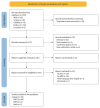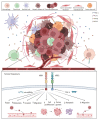Neuropilins as potential biomarkers in hepatocellular carcinoma: a systematic review of basic and clinical implications
- PMID: 36726054
- PMCID: PMC10121286
- DOI: 10.3350/cmh.2022.0425
Neuropilins as potential biomarkers in hepatocellular carcinoma: a systematic review of basic and clinical implications
Abstract
Hepatocellular carcinoma (HCC) is one of the most common and deadly cancers worldwide and is characterized by complex molecular carcinogenesis. Neuropilins (NRPs) NRP1 and NRP2 are the receptors of multiple proteins involved in key signaling pathways associated with tumor progression. We aimed to systematically review all the available findings on their role in HCC. We searched the Scopus, Web of Science (WOS), PubMed, Cochrane and Embase databases for articles evaluating NRPs in preclinical or clinical HCC models. This study was registered in PROSPERO (CRD42022349774) and include 49 studies. Multiple cellular and molecular processes have been associated with one or both NRPs, indicating that they are potential diagnostic and prognostic biomarkers in HCC patients. Mainly NRP1 has been shown to promote tumor cell survival and progression by modulating several signaling pathways. NRPs mainly regulate angiogenesis, invasion and migration and have shown to induce invasion and metastasis. They also regulate the immune response and tumor microenvironment, showing a crucial interplay with the hypoxia response and microRNAs in HCC. Altogether, NRP1 and NRP2 are potential biomarkers and therapeutic targets, providing novel insight into the clinical landscape of HCC patients.
Keywords: Biomarker; Hepatocellular carcinoma; Neuropilins; Systematic review.
Conflict of interest statement
The authors have no conflicts to disclose.
Figures



Similar articles
-
External beam radiotherapy for unresectable hepatocellular carcinoma.Cochrane Database Syst Rev. 2017 Mar 7;3(3):CD011314. doi: 10.1002/14651858.CD011314.pub2. Cochrane Database Syst Rev. 2017. PMID: 28267205 Free PMC article.
-
Ablative and non-surgical therapies for early and very early hepatocellular carcinoma: a systematic review and network meta-analysis.Health Technol Assess. 2023 Dec;27(29):1-172. doi: 10.3310/GK5221. Health Technol Assess. 2023. PMID: 38149643 Free PMC article.
-
Antidepressants for pain management in adults with chronic pain: a network meta-analysis.Health Technol Assess. 2024 Oct;28(62):1-155. doi: 10.3310/MKRT2948. Health Technol Assess. 2024. PMID: 39367772 Free PMC article.
-
Systemic pharmacological treatments for chronic plaque psoriasis: a network meta-analysis.Cochrane Database Syst Rev. 2021 Apr 19;4(4):CD011535. doi: 10.1002/14651858.CD011535.pub4. Cochrane Database Syst Rev. 2021. Update in: Cochrane Database Syst Rev. 2022 May 23;5:CD011535. doi: 10.1002/14651858.CD011535.pub5. PMID: 33871055 Free PMC article. Updated.
-
Systemic pharmacological treatments for chronic plaque psoriasis: a network meta-analysis.Cochrane Database Syst Rev. 2017 Dec 22;12(12):CD011535. doi: 10.1002/14651858.CD011535.pub2. Cochrane Database Syst Rev. 2017. Update in: Cochrane Database Syst Rev. 2020 Jan 9;1:CD011535. doi: 10.1002/14651858.CD011535.pub3. PMID: 29271481 Free PMC article. Updated.
Cited by
-
Advances in the study of disulfidptosis in digestive tract tumors.Discov Oncol. 2025 Feb 15;16(1):186. doi: 10.1007/s12672-025-01875-y. Discov Oncol. 2025. PMID: 39954025 Free PMC article. Review.
-
Biomarkers of Tumor Metastasis and Invasiveness.Cancers (Basel). 2023 Oct 16;15(20):5000. doi: 10.3390/cancers15205000. Cancers (Basel). 2023. PMID: 37894367 Free PMC article.
-
Multi-omics dissection of CPNE1 reveals its prognostic value and immune-regulatory function in liver cancer.Discov Oncol. 2025 Aug 7;16(1):1499. doi: 10.1007/s12672-025-03366-6. Discov Oncol. 2025. PMID: 40775545 Free PMC article.
-
Tumor Microenvironment Composition and Related Therapy in Hepatocellular Carcinoma.J Hepatocell Carcinoma. 2023 Nov 21;10:2083-2099. doi: 10.2147/JHC.S436962. eCollection 2023. J Hepatocell Carcinoma. 2023. PMID: 38022729 Free PMC article. Review.
-
Integrated analysis of disulfidoptosis-related genes identifies NRP1 as a novel biomarker promoting proliferation of gastric cancer via glutamine mediated energy metabolism.Discov Oncol. 2024 Aug 7;15(1):337. doi: 10.1007/s12672-024-01217-4. Discov Oncol. 2024. PMID: 39110136 Free PMC article.
References
-
- Sung H, Ferlay J, Siegel RL, Laversanne M, Soerjomataram I, Jemal A, et al. Global cancer statistics 2020: GLOBOCAN estimates of incidence and mortality worldwide for 36 cancers in 185 countries. CA Cancer J Clin. 2021;71:209–249. - PubMed
-
- Llovet JM, Kelley RK, Villanueva A, Singal AG, Pikarsky E, Roayaie S, et al. Hepatocellular carcinoma. Nat Rev Dis Primers. 2021;7:6. - PubMed
-
- Forner A, Reig M, Bruix J. Hepatocellular carcinoma. Lancet. 2018;391:1301–1314. - PubMed
Publication types
MeSH terms
Substances
Grants and funding
LinkOut - more resources
Full Text Sources
Medical
Miscellaneous

